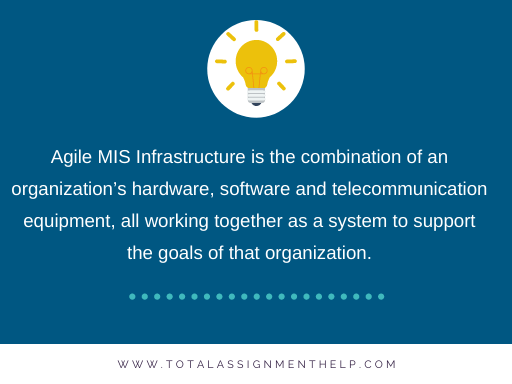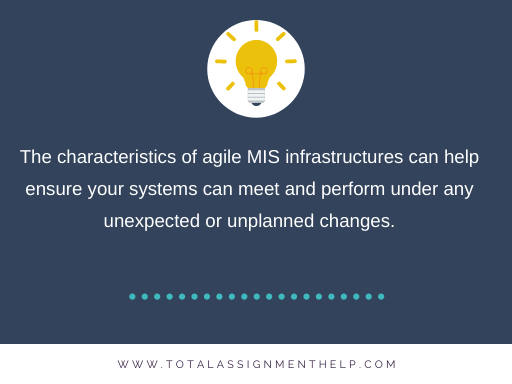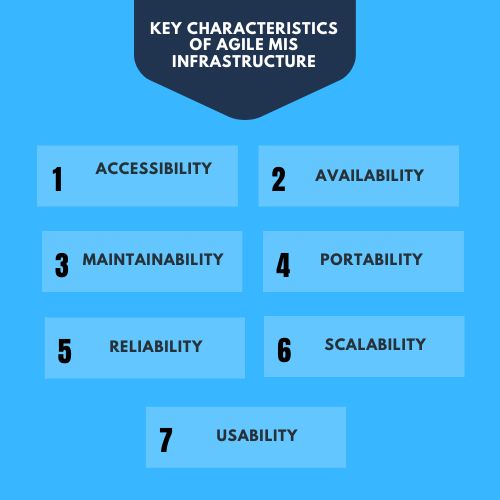Importance And Efficiency Of Agile Mis Infrastructure For Smooth Business Operations
Question
Task: Describe the concepts and principles of Agile MIS Infrastructure.
Answer
Introduction
Agile MIS Infrastructure is the method of exchanging knowledge and resources inside an organization between participants. In order to provide products and services to consumers, a business is completely reliant on this networking framework. It enhances the activities of the business operation to maximize efficiency and therefore improve the company's earnings (Su, Z.Ouyang, & Chen, 2008). The improvement in company operations is enabled by the Agile MIS infrastructure.

Features of Agile MIS Infrastructure
- Ease of access: It determines the user's access capability as well as their output potential at the period of running a device. The user accesses the programme, and often the program is accessible only by the manager, so every other person, even the supervisor unit, has certain restrictions on using it.
- Promptness: When the machine is working long hours, the product service quality will be strong, but it will be inaccessible to the customer if it is not working, and the purchase decision would not take effect.
- Usability: The program must be correctly managed. System management ensures that the customer can instantly access information so that the transaction process can be conveniently handled by the administrator. The program is to be controlled according to the organizational change, which implies a variation in the needs and interests of the consumer.
- Connectivity: If the program is to be used on various types of systems (computers, tablets, cell phones, etc.), the framework should be scalable.
- Consistency: It guarantees whether or not a program is properly run. If it works correctly, then it provides the user with precise details. The detailed knowledge ensures that there is no flaw in the process and that it is readily available.
- Optimization: In order to fulfil the consumer’s desires, it enhances the pace of growth. This implies that perhaps the program's efficiency to improve the demand of the product is one in which the consumers are pleased with the experience.
- Functionality: It includes recognizing the expectations of the consumer. The framework is to be built in such a manner so that it could be effectively used and the team can directly recognize the method of using it (Baltzan, Phillips, Lynch, & Blakey, 2008)

One of the world's biggest online retailers, Amazon uses the internet to sell and deliver goods and products to the doorstep of consumers. The company sells a wide range of products on their website, from electronics, furniture, groceries, clothing, footwear, jewellery and even hardware tools and plant. Amazon sells and delivers almost every product available in the market and generates a great profit. The features of the Agile MIS infrastructure are important to Amazon as an enterprise because of their wide range of products and services. The below points highlight the applicability of the features:

- Ease of access: Amazon has direct exposure to the consumers’ personal details for receipt of the goods, shipping the package, and also for the purchasing decision. They do not reveal details about the consumer to any third-party firm and hold this data very secretive. As per their corporate policy, Amazon retains their company's privacy and protection. The entire supply chain should be controlled by the administration.
- Promptness: It depicts the arrival date of the commodity once the order is placed. Consumers have to pay the price of a particular product whenever the item is ready. Once the account data has been entered, the payment is verified. But if the item is already out of storage, it indicates that the item is not eligible and asks that the order be issued. Whenever it's readily accessible, they pledge to deliver the goods, so it takes place after a certain amount of time. Amazon tells the customer whether the item is ready or not, via e-mail.
- Usability: Amazon adequately manages their system applications. New goods and their associated attributes are reviewed. There are several Amazon rivals, but in order to be competitive with their rivals, they decrease the cost of the goods to improve competitiveness. They attract their consumers by providing the best quality of products and services, such as delivering the goods on schedule, meeting the requirements and desires of the customer, offering high-quality goods. With each day, they have had to change their commodities as per the requirements of the consumers.
- Connectivity: The consumers place the orders online through a mobile, tablet, or PC. They often use electronic devices by installing the applications on the smartphone for the purchasing as well as payment procedures.
- Consistency: The consumer must concentrate on whether the platform offers reliable product specifications at the time of ordering and purchasing the products since incorrect information would bring the incorrect shipment.
- Optimization: The client's input is the priority of Amazon. It enhances their efficiency by raising the number of commodities and the value of the goods. Therefore, it increases the rate of economic growth for the company.
- Functionality: Amazon uses a simple strategy using the Agile MIS infrastructure approach to make it easier for consumers to order their desired products (Smith & Linden, 2017).


Conclusion
The Agile MIS Infrastructure offers knowledge that can be utilized to accomplish the objectives of the business. Agile MIS Infrastructure attributes are relevant to online retailer Amazon. They update the improvements on time and provide the consumer with the correct data as well. It enhances the level of expansion and revenue as well.
Bibliography
Baltzan, P., Phillips, A., Lynch, K., & Blakey, P. (2008). Business driven information systems. New York: McGraw-Hill/Irwin.
Smith, B., & Linden, G. (2017). Two decades of recommender systems at Amazon. com. Ieee internet computing, 21(3), 12-18.
Su, J., Z.Ouyang, & Chen, Y. (2008). Research on agile infrastructure for collaborative manufacturing and agile supply chain. IEEE Conference on Robotics, Automation and Mechatronics, 504-508.












